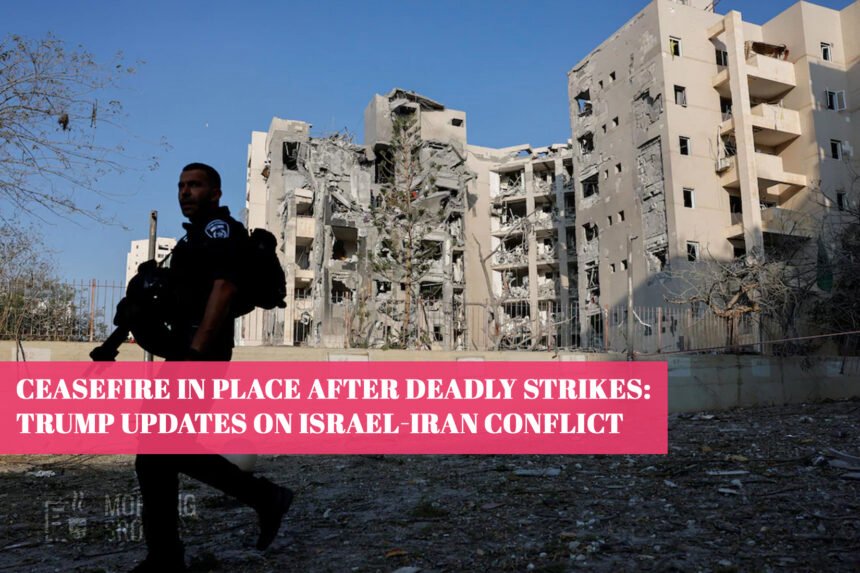With dawn breaking in both Israel-Iran Conflict, doubts lingered about the ceasefire declared by U.S. President Donald Trump only hours before. The details of when or even if the ceasefire would take effect were unclear, and fighting between the two countries continued into the morning.
Ongoing Strikes Despite Ceasefire Announcement
President Trump made his ceasefire declaration late Monday night, Eastern Time, following a significant escalation: Iran had launched a missile attack on the U.S.-run Al Udeid Air Base in Qatar as retaliation for American strikes on Iranian nuclear sites. Despite the announcement, violence did not immediately stop. In the early hours of Tuesday, Iran fired a series of missiles at Israel, striking residential areas and forcing many Israelis to seek shelter in bomb shelters for nearly two hours. At least three people were killed in the southern Israeli city of Beer Sheva, and others were injured.
Meanwhile, Israel responded with its attacks, targeting sites in and around Tehran, including facilities connected to Iran’s nuclear and missile programs and high-ranking military officials. The Israeli military urged citizens to remain close to shelters, even as it announced people could leave them after the initial barrage.
Ceasefire Terms and Mediation
The ceasefire, which Qatar helped to broker, was announced by Trump as a “complete and total” agreement set to begin roughly six hours after his statement—around 7 a.m. in Israel. However, neither side initially gave clear confirmation. According to Iranian state media, the ceasefire was forced upon their opponents, portraying it as a consequence of Iran’s military retaliation against the U.S. They also reported that Trump had requested the ceasefire “in a pleading manner.” At the same time, Trump himself said that both Israel and Iran had approached him about ending the conflict.
According to White House officials, Israel agreed to the ceasefire on the condition that Iran stop its attacks, and Iran accepted these terms. U.S. officials credited the recent American strikes on Iranian nuclear sites for making the ceasefire possible, and President Trump thanked Qatar’s Emir for his role in mediating the agreement.

Missile Strikes and Civilian Impact
Despite the diplomatic efforts, missile launches continued into Tuesday morning. Iranian missiles targeted several Israeli cities, including Jerusalem and Haifa, with one missile hitting a residential building in Beer Sheva, killing three and injuring others. Videos showed Israeli air defenses intercepting missiles over major cities.
Israel’s military also launched strikes on Tehran and other sites in Iran, hitting locations tied to the country’s nuclear and missile programs. Iranian officials reported casualties among senior military commanders and other personnel.
The Attack on Al Udeid Air Base
Iran’s missile attack on the Al Udeid Air Base in Qatar was a direct response to U.S. airstrikes on Iranian nuclear facilities over the weekend. The U.S. had warning of the attack and was able to intercept most of the missiles, with no reported casualties. The base, which is the largest U.S. military installation in the Middle East, plays a crucial role in American operations throughout the region.
Iranian officials emphasized that their attack was carefully planned to avoid civilian areas in Qatar, signaling a desire to avoid further escalation with the Gulf state. They also said that the number of missiles fired matched the number of bombs used by the U.S. in its earlier strike, suggesting a calculated response rather than an attempt to widen the conflict.
Diplomatic Efforts and Uncertain Peace
Qatar played a key role in mediating the ceasefire. After Iran’s retaliatory strike on the U.S. base, President Trump asked the Emir of Qatar to help negotiate an end to the hostilities. The Qatari Prime Minister secured Iran’s agreement, and Trump announced the ceasefire on social media. However, both Israeli and Iranian governments were slow to confirm their acceptance, and fighting continued even as the ceasefire deadline approached.
The Human Cost and Ongoing Tensions
The violence has taken a heavy toll on both sides. In Israel, civilians have been killed and injured by missile strikes, with emergency services working around the clock to respond to attacks. In Iran, Israeli strikes have targeted key military and nuclear sites, resulting in the deaths of senior commanders and other personnel. The exchange of fire has forced ordinary people in both countries to seek shelter and live in fear of further attacks.
While the ceasefire has been announced and accepted in principle, its future remains uncertain. Both sides have suffered losses, and the underlying tensions that led to the conflict are far from resolved. The U.S. and Qatar’s diplomatic efforts have, at least temporarily, halted the escalation, but the situation remains fragile.
President Trump has expressed hope that the ceasefire will become permanent, but the continued missile attacks and lack of clear communication from both Israel and Iran suggest that peace is still uncertain. For now, the world watches closely, hoping that the violence will come to an end and that a more lasting solution can be found.
MUST READ: Trump Confirms Russia-Ukraine Ceasefire Talks after Two-Hour Putin Call








